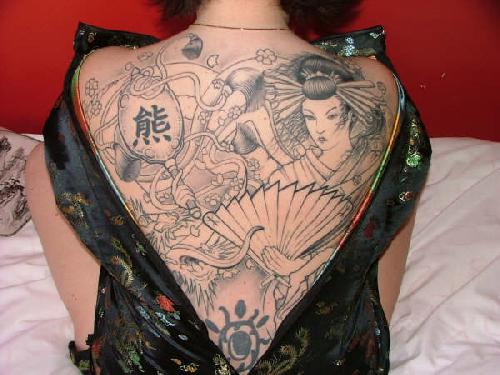You know that the ancient Japanese were intricately tattooed? Relics of discovered art such as statues and pottery revealed this. And the more interesting fact is that Japanese tattoo designs were first inked on the skin of Japanese who were in the upper strata of the society then. Many Japanese history scholars formed the conclusion that Japanese tattoo designs were used in ceremonies that define the ancient Japanese standings in society and to ward off bad spirits. In contrast to the reasons of ancient China's practice of tattooing which had the primary purpose of labeling criminals and society misfits, the Japanese did it to elevate those worthy to be up there in society, thus, it was more of something that brought honor.
Ancient relics such as clay pottery and statues showed images of Japanese people who were intricately tattooed. Even more fascinating, the first Japanese tattoo designs were found on people of high social standing. Many Japanese historians now agree that the earliest Japanese tattoo designs were utilized in rituals to signify the positions of people in society, as well as to provide ways to protect one's self from evil spirits. The Japanese people are one of the first great civilizations to incorporate tattooing into their culture. While in China the art of tattooing began as a way to mark off the prisoners and the other outcasts of society, the Japanese tattoos were valued in a different manner from the start.
Japanese tattoos are rich in inspiration. Like all arts, the Japanese learned to incorporate their most important values into their skin through tattoos. This is the reason why one of the cherished values of the early Japanese people, religion and love, is often the primary motifs of the people's tattoos. The courtesans, artists, and even the geishas of Japan were all acquainted with tattooing and used it as personal markers of their religious backgrounds and who they love. An example of how Japanese tattoo designs were used to symbolize love was in the vow tattoo. Some geishas will have their lover's names imprinted in their arms in order to show their promises of lasting love. Aside from being used for making promises about love, the tattoo in Japanese society also evolved aesthetically.
At certain stages of time, Japanese tattoo designs were characterized with elaborate details. However, there was also a time that the tattoos looked like small markings that looked like a mole. This was during the time when the tattoo served as the reminder of of cherished romantic moments like what part of the body had been touched by a partner. Interestingly, at a particular time of Japanese history, tattoos were used to express political and social sentiments. Regardless of their place in society, almost everyone in Japan wore tattoos to make their sentiments regarding the political status of Japan from the seventeenth century to the nineteenth century known.








